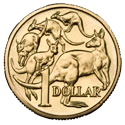Australia | |
| Value | 1.00 AUD |
|---|---|
| Mass | 9.00 g |
| Diameter | 25.00 mm |
| Thickness | 2.80 mm |
| Edge | interrupted milled 0.25 mm 77 notches |
| Composition | 92% Copper, 6% Aluminium, 2% Nickel |
| Years of minting | 1984–present |
| Catalog number | — |
| Obverse | |
| Design | Queen Elizabeth II (1984–2023) King Charles III (2023–present) [1] |
| Designer | Various (1984–2023) Dan Thorne (2023–present) [2] |
| Design date | 2023 |
| Reverse | |
 | |
| Design | Five kangaroos |
| Designer | Stuart Devlin |
| Design date | 1983 |
The Australian one-dollar coin is the second most valuable circulation denomination coin of the Australian dollar after the two-dollar coin; there are also non-circulating legal-tender coins of higher denominations (five-, ten-, and two-hundred-dollar coins [3] ).
Contents
It was first issued on 14 May 1984 [4] to replace the one-dollar note which was then in circulation, although plans to introduce a dollar coin had existed since the mid-1970s. [4] The first year of minting saw 186.3 million of the coins produced at the Royal Australian Mint in Canberra. [4]
Four portraits of Queen Elizabeth II have featured on the obverse, the 1984 head of Queen Elizabeth II by Arnold Machin; between 1985 and 1998, the head by Raphael Maklouf; between 1999 and 2009, the head by Ian Rank-Broadley; and since 2019, the effigy of Elizabeth II by artist Jody Clark has been released into circulation. The coin features an inscription on its obverse of AUSTRALIA on the right-hand side and ELIZABETH II on the left-hand side. One-dollar coins bearing the portrait of King Charles III entered circulation in December 2023. [1]
The reverse features five kangaroos. The image was designed by Stuart Devlin, who designed Australia's first decimal coins in 1966.
The one-dollar denomination was only issued in coin sets in 1987, 1989, 1990, 1991, 1992, and 2012. No one-dollar coin with any mint mark was ever released for circulation; any dollars found with such mark comes for a card.[ clarification needed ]
One-dollar coins are legal tender for amounts not exceeding 10 times the face value of the coin for any payment of a debt. [5]